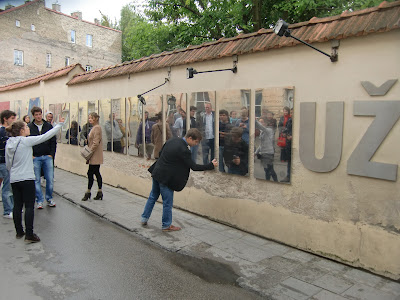If you're still not convinced of Siauliai's awesomeness after a trip to the Hill of Crosses (see previous post), then why not take a peek inside one of the other off-beat attractions around town, such as the Bicycle Museum, the Radio and Television Museum, and most interestingly, the Museum of Cats.
Not being a cat owner nor fond of felines, excluding Catwoman in her shiny skin-tight suit (meow!), I wasn't particularly interested in the Museum of Cats but it seemed too good to pass up, even just for bragging rights. (How many of your friends have set foot inside a cat museum?).
Once again, the tourist office staff in Siauliai proved invaluable in giving directions, though they were a bit vague ("somewhere around here") when circling the area on the map to indicate the museum's location. No wonder, since it was outside Siauliai's city center and thus just off the edge of the map.
Not to be deterred, I walked in the general direction of the museum, and came across a lake. Lo and behold, a large scale figure (about 4 stories high) of a cat stood guard over the lake, just enticing passers-by to snap a photo. I wondered what sort of affection Lithuanians had with
felines and why, and continued on my way.
Eventually landed in a residential section of town and having neglected to bring the museum's address, I walked around aimlessly and was on the verge of giving up, when I spotted this sign."Psst...that way", it indicated to this tired and hapless traveler almost undone by his curiosity.
Re-energized, I retraced my steps, and found what might look like a museum (or a schoolhouse), and entered the gate. Eureka, I'd found it! The museum's well-hidden sign (top photo) was a dead giveaway, though the place looked deserted. I climbed up a flight of stairs, opened a door and stepped into a hallway where I could hear children's voices. Those turned out to be the museum's only other guests aside from myself - a gaggle of fifteen to twenty kids on a field trip.


After paying the 5 litas admission fee, I stepped Inside the first of the museum's three separate rooms to find memorabilia of every kind related to cats. Tons and tons of porcelain stuff, framed photographs and paintings hugging the walls, poems and letters from all over the world, etc. Several photos of whom I assume to be the museum's founder and her beloved pets were also present.
After spending roughly half an hour looking around and taking photos, I got tired of it. (Again, not much of a cat lover). The museum's only live cat followed me around (the group of school kids had somehow vanished), casting a baleful gaze as she did, so I took that as my cue to make an exit.

































